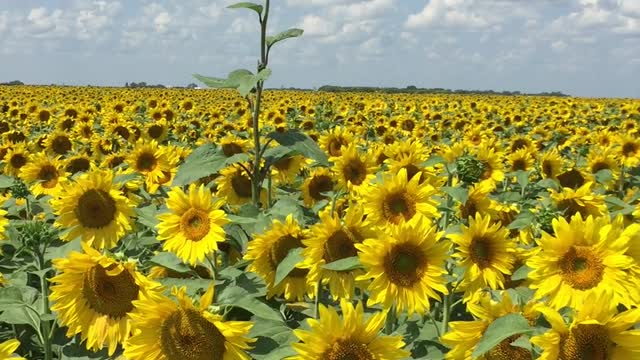Premium Only Content

Gorgeous Sunflower field in Manitoba
By end of July you may often see Gorgeous sunflower fields like this all over Southern Manitoba. Did you know that Manitoba is the highest exporter of sunflower seeds in Canada? Canada is the world's 13th largest exporter and 25th largest grower of sunflower seeds, producing both confectionery and oilseed varieties.
The hardy sunflower has a wide range of uses, from the confectionary and baking industries, to the birdseed industry, and the animal feed industry.
Grade standards for both confection and oil type sunflowers are established by the Canadian Grain Commission. Confection standards are considerably higher than those for oil type sunflowers since they are used for direct human consumption.
Sunflower seeds contain almost every vitamin (except Vitamin C) and substantial amounts of key minerals, including magnesium, iron, copper, and zinc. Given their high protein content, sunflower seeds can serve as a meat substitute.
Non-oil or confectionery type sunflowers have striped hulls and can be roasted and salted or baked into bread products. Only the largest of confection type sunflowers are used for human consumption, with little tolerance for bird or insect damage.
Confectionery sunflower seeds fall into three categories: in shell, kernel, and birdseed. Larger sunflower seeds (in shell) are roasted, salted and packaged for human consumption and are classified as either large or jumbo. Medium-sized seeds (kernel) are de-hulled and primarily used for the bakery industry, as well as traded domestically and exported. Smaller seeds, known as "striped bird food," are sold in North American birdseed markets.
The black-shelled oilseed variety is richer in oil and better suited for the production of sunflower oil. The oil in sunflower seed is very high in polyunsaturated fatty acids.
The majority of oil sunflower seeds are crushed after the hull is removed. The oil is used for frying or to produce salad dressings, shortening, and margarine. The meal which usually contains about 35% protein, is used in livestock feed.
The birdfood market is comprised of about 85% oilseed sunflowers, however some of the smaller confection seeds are also used for birdseed. Sunflower seeds provide high-energy feed for livestock due to their high fat content. Cattle producers can replace a part of barley grain/silage with sunflower seeds to enhance conjugated linoleic acids (CLA) content in milk and meat. Feeding whole sunflower seeds to dairy cattle as a way to increase the energy content of the diet of high-producing dairy cows may boost milk production by 3-5%. This can provide sunflower growers with an alternative market outlet for sunflower seeds, in times of low prices or damaged seeds.
-
 LIVE
LIVE
megimu32
1 hour agoOTS: Mighty Morphin Power Rangers & the 90s Movie That Defined a Generation
133 watching -
 LIVE
LIVE
Badlands Media
16 hours agoThe SITREP Ep. 128
1,502 watching -
 LIVE
LIVE
BubbaSZN
1 hour ago🔴 LIVE - FORTNITE WITH NEW KEYBOARD
79 watching -
 LIVE
LIVE
Mally_Mouse
2 hours agoThrowback Thursday! Let's Play: Cuphead
104 watching -
 LIVE
LIVE
StevieTLIVE
2 hours agoWarzone HYPE Duos with GloryJean
42 watching -
 1:05:11
1:05:11
Donald Trump Jr.
4 hours agoBuilding the Future with American Bitcoin, Plus Eric's Triggered Debut! | TRIGGERED Ep.272
107K54 -
 LIVE
LIVE
RaikenNight
5 hours agoThe Baldur Boyz are on a Mission to Save the City
10 watching -
 LIVE
LIVE
Misfit Electronic Gaming
5 hours ago"LIVE" "Loan Shark" Demo + Managed Democracy "HellDivers 2" Phasmophobia with LNR + "REPO" W/Crew
27 watching -
 LIVE
LIVE
MissesMaam
7 hours agoLetting a Game from 2009 RageBait Me | Achievement Hunting PVZ 💚✨
38 watching -
 1:01:40
1:01:40
The Nick DiPaolo Show Channel
6 hours agoTrump Waiting On Tariff Ruling | The Nick Di Paolo Show #1788
33.9K21